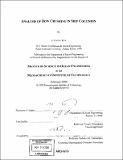Analysis of bow crushing in ship collision
Author(s)
Kim, Ji Young, 1968-
DownloadFull printable version (12.88Mb)
Other Contributors
Massachusetts Institute of Technology. Dept. of Ocean Engineering.
Advisor
Tomasz Wierzbicki.
Terms of use
Metadata
Show full item recordAbstract
Collision of ships with oil tankers poses, next to grounding, one of the most serious environmental threats at sea. In many previous analyses of the collision problem, the bow of the impacting ship was considered rigid. The objective of the present research is to include the finite strength of the bow in the overall collision simulation. The emphasis will be placed on typical raked shapes because some work already has been reported in the past on bulbous bows. The main structural members will include side shell and the deck. Transverse and longitudinal stiffeners will be taken into account by means of a smearing technique. A structural model is developed by identifying localized zones of plastic deformations from photographs of damaged ships. Then, the contributions of the membrane and bending resistance is assessed and a simple computational model is developed. The solution includes determination of the force-indentation relationship, a number of folds and a total amount of damage for a given speed of a ship. Five scale model tests were run and the force-deflection characteristics were recorded. A good correlation was obtained between the analytical solution and experimental results.
Description
Thesis (S.M.)--Massachusetts Institute of Technology, Dept. of Ocean Engineering, 2000. Includes bibliographical references (leaves 108-110).
Date issued
2000Department
Massachusetts Institute of Technology. Department of Ocean EngineeringPublisher
Massachusetts Institute of Technology
Keywords
Ocean Engineering.